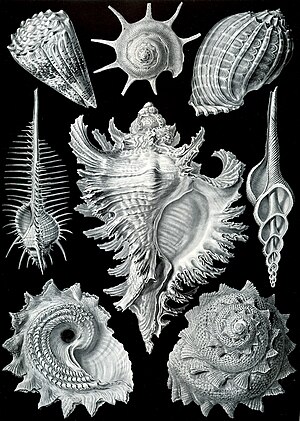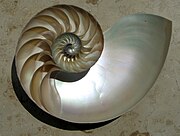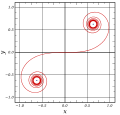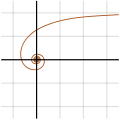Spiral
From Wikipedia, the free encyclopedia
| This article needs additional citations for verification. Please help improve this article by adding reliable references (ideally, using inline citations). Unsourced material may be challenged and removed. (July 2007) |
In mathematics, a spiral is a curve which emanates from a central point, getting progressively farther away as it revolves around the point.
Contents |
[edit] Spiral or helix
A "spiral" and a "helix" are two terms that are easily confused, but represent different objects.
A spiral is typically a planar curve (that is, flat), like the groove on a record or the arms of a spiral galaxy. A helix, on the other hand, is a three-dimensional coil that runs along the surface of a cylinder, like a screw. There are many instances where in colloquial usage spiral is used as a synonym for helix, notably spiral staircase and spiral binding of books. Mathematically this is incorrect but the terms are increasing in common usage.
In the side picture, the black curve at the bottom is an Archimedean spiral, while the green curve is a helix. A cross between a spiral and a helix, such as the curve shown in red, is known as a conic helix. An example of a conic helix is the spring used to hold and make contact with the negative terminals of AA or AAA batteries in remote controls.
[edit] Two-dimensional spirals
A two-dimensional spiral may be described most easily using polar coordinates, where the radius r is a continuous monotonic function of angle θ. The circle would be regarded as a degenerate case (the function not being strictly monotonic, but rather constant).
Some of the more important sorts of two-dimensional spirals include:
- The Archimedean spiral: r = a + bθ
- The Euler spiral, Cornu spiral or clothoid
- Fermat's spiral: r = θ1/2
- The hyperbolic spiral: r = a/θ
- The lituus: r = θ-1/2
- The logarithmic spiral: r = abθ; approximations of this are found in nature
- The Fibonacci spiral and golden spiral: special cases of the logarithmic spiral
- The Spiral of Theodorus: an aproximation of the Archimedean spiral composed of contiguous right triangles
[edit] Three-dimensional spirals
For simple 3-d spirals, a third variable, h (height), is also a continuous, monotonic function of θ. For example, a conic helix may be defined as a spiral on a conic surface, with the distance to the apex an exponential function of θ.
The helix and vortex can be viewed as a kind of three-dimensional spiral.
For a helix with thickness, see spring (math).
Another kind of spiral is a conic spiral along a circle. This spiral is formed along the surface of a cone whose axis is bent and restricted to a circle:
This image is reminiscent of a Ouroboros symbol and could be mistaken for a torus with a continuously-increasing diameter:
[edit] Spherical spiral
A spherical spiral (rhumb line or loxodrome, left picture) is the curve on a sphere traced by a ship traveling from one pole to the other while keeping a fixed angle (unequal to 0° and to 90°) with respect to the meridians of longitude, i.e. keeping the same bearing. The curve has an infinite number of revolutions, with the distance between them decreasing as the curve approaches either of the poles.
The gap between the curves of an Archimedean spiral (right picture) remains constant as the radius changes and is hence not the same thing as the rhumb line described earlier.
[edit] As a symbol
The spiral plays a certain role in symbolism, and appears in megalithic art, notably in the Newgrange tomb or in many Galician petroglyphs such as the one in Mogor. See also triple spiral.
While scholars are still debating the subject, there is a growing acceptance that the simple spiral, when found in Chinese art, is an early symbol for the sun. Roof tiles dating back to the Tang Dynasty with this symbol have been found west of the ancient city of Chang'an (modern-day Xian).
The spiral is the most ancient symbol found on every civilized continent. Due to its appearance at burial sites across the globe, the spiral most likely represented the "life-death-rebirth" cycle. Similarly, the spiral symbolized the sun, as ancient people thought the sun was born each morning, died each night, and was reborn the next morning.
Spirals are also a symbol of hypnosis, stemming from the cliché of people and cartoon characters being hypnotized by staring into a spinning spiral (One example being Kaa in Disney's The Jungle Book). They are also used as a symbol of dizziness, where the eyes of a cartoon character, especially in anime and manga, will turn into spirals to show they are dizzy or dazed. The spiral is also a prominent symbol in the anime Gurren Lagann, where it symbolizes the double helix structure of DNA, representing biological evolution, and the spiral structure of a galaxy, representing universal evolution.
[edit] In nature

The study of spirals in nature have a long history, Christopher Wren observed that many shells form a logarithmic spiral. Jan Swammerdam observed the common mathematical characteristics of a wide range of shells from Helix to Spirula and Henry Nottidge Moseley described the mathematics of univalve shells. D’Arcy Wentworth Thompson's On Growth and Form gives extensive treatment to these spirals. He describes how shells are formed by rotating a closed curve around a fixed axis, the shape of the curve remains fixed but its size grows in a geometric progression. In some shell such as Nautilus and ammonites the generating curve revolves in a plane pirpendicular to the axis and the shell will form a planer discoid shape. In others it follows a skew path forming a helico-spiral pattern.
Thompson also studied spirals occurring in horns, teeth, claws and plants.[1]
Spirals in plants and animals are frequently described as whorls.
A model for the pattern of florets in the head of a sunflower was proposed by H Vogel. This has the form
where n is the index number of the floret and c is a constant scaling factor, and is a form of Fermat's spiral. The angle 137.5° is related to the golden ratio and gives a close packing of florets.[2]
The spiral also represents infinance, or 'infinity.' Starting at a single point, and revolving outwardly until the end of the universe. Because of this, some civilizations believe that the Spiral is a pathway to the afterlife.
[edit] References
- ^ Thompson, D'Arcy (1917,1942), On Growth and Form
- ^ Prusinkiewicz, Przemyslaw; Lindenmayer, Aristid (1990). The Algorithmic Beauty of Plants. Springer-Verlag. pp. 101–107. ISBN 978-0387972978. http://algorithmicbotany.org/papers/#webdocs.
[edit] See also
- Seashell surface
- Celtic maze (straight-line spiral)
[edit] External links
| Wikimedia Commons has media related to: Spiral |
- SpiralZoom.com, an educational website about the science of pattern formation, spirals in nature, and spirals in the mythic imagination.
- Geoff Ward. Spirals: the Pattern of Existence. UK: Green Magic. ISBN 0 9547 2309 0.














